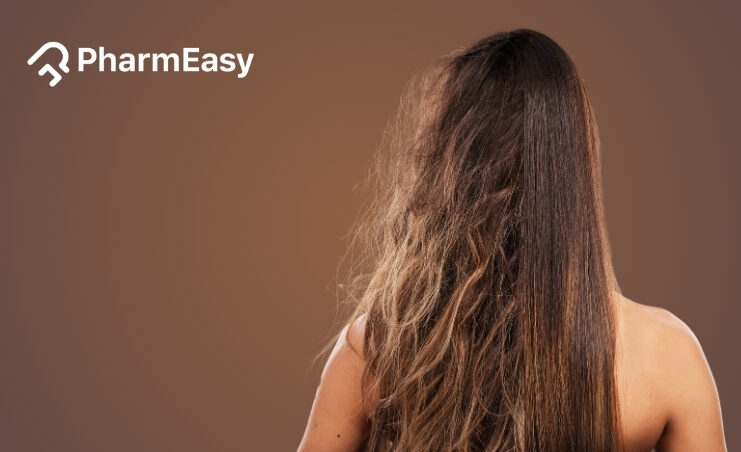How To Increase Melanin In Hair Naturally
By Dr. Raina N. Nahar +2 more

Get,

to manage your symptom
Get your,


4 Cr+ families
benefitted

OTP sent to 9988776655



You’ve successfully subscribed to receive
doctor-approved tips on
Whatsapp

Get ready to feel your best.

Hi There,
Download the PharmEasy App now!!


Register to Avail the Offer
Send OTPBy continuing, you agree with our Privacy Policy and Terms and Conditions

Hi There,
Sign up on PharmEasy now!!
Trusted by 4 crore+ families

OTP sent to 9988776655



You have unlocked 25% off on medicines




Code: NU25
By Dr. Raina N. Nahar +2 more
Table of Contents
The natural pigment melanin plays a crucial role in determining your hair colour, skin colour and eye colour as well as protects from the harmful effects of ultraviolet (UV) rays1. Over time, the production of melanin in your hair may slow down or stop altogether, leading to grey or white hair2. While this is a natural part of the ageing process, many people seek ways to restore their hair colour and vitality. This article will explore the role of melanin in hair, discuss potential ways to increase melanin production, and offer guidance on natural methods that may help support melanin production and maintain your hair colour.

Melanin is a pigment made by cells called melanocytes. These are found in the hair follicles. The type and amount of melanin in your hair decides whether your natural hair colour is black, brown, blonde, or red3. Genetic factors decide what kind of melanin you have. They also decide your hair colour. The blend of eumelanin (black and brown forms of melanin) and pheomelanin (red-yellow pigment form) creates a range of hair colours.
Apart from deciding your hair colour, melanin shields your hair from the harmful UV rays of the sun. UV rays cause hair damage like loss of colour and also weaken the structure of hair by causing oxidative stress. Higher concentrations of eumelanin in hair cause less risk of UV-induced hair damage, whereas higher concentrations of pheomelanin can increase this risk by making it more prone to oxidative stress4. The right level of melanin in your hair helps keep your hair safe and strong.
With age, the melanocytes in your hair follicles slow their work. This leads to less melanin production. Over time, your hair can look grey or white4. Several other factors, including genetics, autoimmune disease, and nutritional deficiencies, can also affect your hair colour3.
Significant changes in melanin production can affect your hair colour. But that’s not all. It may also affect the health of your hair. Melanin protects your hair from UV damage. It strengthens the hair shaft and scalp by promoting hair growth. Thus, keeping healthy melanin levels may be important for the strength and fullness of your hair4.
Many melanin supplements claim they boost melanin production and restore hair colour as well. However, there is little scientific proof to this claim. Most of these supplements are not approved by the FDA7. So, their safety and possible side effects are a concern. Just like any supplement, it’s crucial to discuss with your healthcare provider before starting melanin supplements.
A few studies suggest that certain nutrients, like vitamin B12, copper, iron, zinc, vitamin C, and vitamin D, may boost melanin synthesis in the hair8. However, we need more research to confirm this. Overconsumption of these nutrients through food or supplements can cause unwanted side effects and health problems. So, always follow your healthcare provider’s advice when taking any supplements.
Melanin supplements can cause side effects, especially if taken without a healthcare professional’s guidance. These side effects could include allergic reactions, liver problems, vision loss, nausea, and unnatural tan. More so, taking supplements such as vitamin tablets, iron, and copper may interact with certain medicines like blood thinners, blood pressure-lowering medicines, thyroid medicines, and birth control pills. Avoid melanin supplements if you’re pregnant, breastfeeding, or if you are taking any of these medicines.
A healthy diet full of antioxidants, copper, and key vitamins can support hair follicles and is said to boost melanin production9. Incorporating these nutrients in your diet may support healthier hair; however, more long-term human studies are needed to confirm their role in reducing greying of hair.
Including vitamin B6 and B12 in your diet may boost melanin production in your hair. Vitamin B6, also known as pyridoxine, helps activate enzymes that metabolise hair proteins like keratin and melanin. One study10 showed that taking pyridoxine supplements resulted in increase in hair colour, while other studies showed it led to increased overall hair health in women with hair loss disorders11.
Vitamin B12 primarily boosts red blood cell production. These cells, in turn, are said to support better keratin production and enhanced hair growth by rapid proliferation of hair follicles12.
An older study found that people with pernicious anaemia (marked by vitamin B12 deficiency) were more likely to experience hair greying before age 509. This implies that getting enough vitamin B12 may help maintain healthy levels of melanin in your hair and avoid early greying.
Foods high in vitamin B6 include meat, poultry, fish, eggs, dairy, peanuts, pork, bananas, oats, soya beans, and whole grains. Foods rich in vitamin B12 include meat, milk, eggs, fish, cheese, and fortified cereals13. By including these nutrient-rich foods in your daily diet, you may support hair health and melanin production.
There’s no clear scientific evidence to back the potency of topical melanin hair products. However, some users have reported positive results. Discuss with a healthcare professional or dermatologist to ensure its safety and benefits.
Researchers at Northwestern University recently made a new melanin-based hair dye that copies natural human hair pigment. This unique product is said to offer potentially safer hair colour therapy than traditional chemical-based dyes14. Like any new hair colour product, always discuss it with a professional before using it to get the best results and keep away from possible reactions or harm to your hair.
Also Read: 5 Amazing Benefits Of Castor Oil For Hair
If there’s an imbalance in your hormones, particularly thyroid hormones, it can affect your hair by influencing both your hair cycle and its colour15. If you feel a hormonal imbalance is changing your hair colour or texture, talk to a healthcare professional. Get any necessary testing done, find out potential problems, and start the right management under the guidance of a doctor.
We know stress affects many aspects of health. Research suggests it may even play a role in melanin production in your hair. Mental stress affects the stem cells in the hair follicles. This could lead to early greying or changes in hair colour9. By managing stress, you may help lower the impact of stress on your melanin production and overall hair health. You may do this by following practices like meditation, mindfulness, exercise, deep breathing exercise, yoga and spending time with loved ones.
Too much sun and UV exposure can cause structural impairments in the hair shaft and loss of protein and hair colour as it affects your hair’s melanin levels16. This may lead to early greying or fading of hair colour. To cut down the impact of UV exposure on your hair, make sure to protect your hair by wearing a wide-brimmed hat, using sun-protecting hair care products, and steering clear of long exposure to direct sunlight.
Also Read: What Causes White Hair at an Early Age?
The frequent use of hair care products that contain strong chemicals, such as sulfates, petrochemicals, parabens, and silicones, can rob your hair of its natural melanin9. This can fade hair colour or increase the risk of damage. Also, if you regularly undergo chemical hair treatments, like colouring and bleaching, there’s increased penetration of concentrated hydrogen peroxide in hair folicle’s cortex, causing damage to hair. This affects your hair’s melanin content and contributes to greying hair17. To stop chemicals from affecting your hair’s melanin levels, choose gentle hair care products. Make sure they don’t contain sulfates and alcohols. Also, reduce the use of chemical treatments and heat styling tools.
Also Read: Effective Home Remedies for Silky Hair
The pigment melanin plays a vital role in determining your hair colour and protecting your hair from UV damage1. Over time or due to factors like sun exposure, stress, and hormone imbalances, melanin production in the hair may slow or stop. The results in grey or white hair. A holistic approach may help support melanin production. This includes eating antioxidant-rich foods, managing stress and chemical exposure, and practicing sun safety9. These may help maintain your hair’s natural colour and health.
Bringing these changes to your diet and lifestyle can greatly support your hair and overall health. While research is still exploring the benefits of supplements and melanin-boosting foods, a holistic approach that considers all aspects of hair health appears most promising for long-term results. As always, discuss with a healthcare professional before making significant changes to your routine.
Also Read: 9 Essential Monsoon Hair Care Tips For You!
While there’s no proven way to get back melanin in the hair, you may try living healthily and eating right. Foods rich in antioxidants, essential nutrients, and copper may support hair health. You should also learn to manage stress well and follow sun protection rules to keep melanin loss in your hair low.
Foods that may increase melanin in hair include antioxidant-rich foods like berries, nuts, beans, citrus fruits, and leafy greens. Eating foods high in copper, such as crab meat, almonds, lentils, peanuts, and beef liver, may also support melanin production in hair.
To boost melanin naturally, focus on a balanced, nutrient-rich diet. This includes antioxidant-rich foods, foods high in copper, iron, zinc, and vitamins B and D. Besides, manage stress, guard your skin and hair against too much sun, and limit chemical treatments. This could help keep melanin levels in your hair high.
In most cases, once hair has turned grey or white due to less melanin production, it can’t return to its original colour. However, addressing any underlying issues that affect melanin production could help stop more greying.
Disclaimer: The information provided here is for educational/awareness purposes only and is not intended to be a substitute for medical treatment by a healthcare professional and should not be relied upon to diagnose or treat any medical condition. The reader should consult a registered medical practitioner to determine the appropriateness of the information and before consuming any medication. PharmEasy does not provide any guarantee or warranty (express or implied) regarding the accuracy, adequacy, completeness, legality, reliability or usefulness of the information; and disclaims any liability arising thereof.
Links and product recommendations in the information provided here are advertisements of third-party products available on the website. PharmEasy does not make any representation on the accuracy or suitability of such products/services. Advertisements do not influence the editorial decisions or content. The information in this blog is subject to change without notice. The authors and administrators reserve the right to modify, add, or remove content without notification. It is your responsibility to review this disclaimer regularly for any changes.
Comments

Leave your comment...
You may also like
Comments